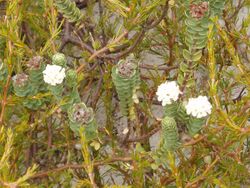Biology:Pimelea villosa
| Pimelea villosa | |
|---|---|

| |
| Pimelea villosa at Puwheke Beach, Karikari Peninsula | |
| Scientific classification | |
| Kingdom: | Plantae |
| Clade: | Tracheophytes |
| Clade: | Angiosperms |
| Clade: | Eudicots |
| Clade: | Rosids |
| Order: | Malvales |
| Family: | Thymelaeaceae |
| Genus: | Pimelea |
| Species: | P. villosa
|
| Binomial name | |
| Pimelea villosa | |
| Synonyms | |
|
Pimelea arenaria | |
Pimelea villosa, also known as Pimelea arenaria, or sand daphne is a species of shrub in the family Thymelaeaceae, known in Māori as autetaranga or autetauranga. It is endemic to New Zealand. Its conservation status puts it at risk and declining, as determined by the New Zealand Threat Classification System (NZTCS).[2] The bark of the tree was occasionally used as traditional textiles such as ribbons or ear ornaments, however was not as commonly used as the paper mulberry (aute) or Hoheria populnea (houhere).[3]
Description
Pimelea villosa is a sprawling shrub with hairy branches. It is found almost exclusively on sand dunes and associated areas. It possesses pointed leaves that are 5 to 15 mm long and 3 to 7mm wide. It also has white flowers and black, red, pink or white fruit.It is classified as at risk or declining there is only one natural place it remains, at Otaki beach where around 20 plants naturally remain.[2]
Nomenclature
This plant was for many years known as Pimelea arenaria, a name published by Allan Cunningham in 1833. However, in 2009 it was pointed out by Burrows[1]:330 that Pimelea villosa, a name proposed by Daniel Solander but not published by him, had been effectively published by James Edward Smith in 1814, and thus has priority.
In the same paper, Burrows[1] proposed to divide P. villosa into two subspecies, P. villosa subsp. villosa and P. villosa subsp. arenaria, basing the latter on Cunningham's specimens. This division remains controversial and is not accepted by some authorities.[2]
The name P. villosa was also applied illegitimately by some nineteenth century authors to an Australian plant, Pimelea longiflora.[4]
References
- ↑ 1.0 1.1 1.2 Burrows, CJ (2009). "Genus Pimelea (Thymelaeaceae) in New Zealand 3. The taxonomic treatment of six endemic hairy-leaved species.". New Zealand Journal of Botany 47 (3): 330–338. doi:10.1080/00288250909509813.
- ↑ 2.0 2.1 2.2 "Pimelea villosa". https://www.nzpcn.org.nz/flora/species/pimelea-villosa/.
- ↑ Neich, Roger (1996). "New Zealand Maori Barkcloth and Barkcloth Beaters". Records of the Auckland Institute and Museum 33: 111–158. ISSN 0067-0464.
- ↑ "Pimelea villosa (Turcz.) Meisn.". https://biodiversity.org.au/nsl/services/name/apni/70974/api/apni-format.
Wikidata ☰ Q17582260 entry
 |

